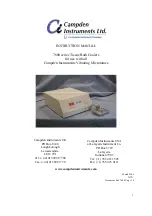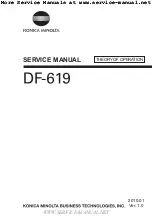
RTC
®
5 PC Interface Board
Rev. 1.9 e
8 Advanced Functions for Scan Head and Laser Control
185
innovators for industry
After
, 2D encoder compensation
is inactive by default. It becomes active as soon as a
valid table from an ASCII-readable text file gets
loaded onto the RTC
®
5 board. You can subsequently
deactivate it by calling
null pointer instead of the filename.
The following rules apply to the text file:
• The file can contain one or several tables, even
tables of other types.
• The 2D compensation table must begin with the
caption
[Fly2DTable<No>]
, whereby
<No>
corre-
sponds to the number supplied with the
command.
• This is directly followed by a block of data points.
• If several tables with the same number exist, then
only data from the first encountered table will be
read. The others will be ignored.
• Reading of the text data terminates upon end of
file or upon a line containing a caption.
• All characters to the right of a semicolon are
treated as comments and ignored.
• The order of data points is up to you.
• The maximum length of a data line is 255
characters.
• A data line contains the two reference point
coordinates for Encoder0 and Encoder1 (signed
integers) and two compensation values (signed
integers), each separated by spaces or tabs:
<Encoder0> <Encoder1> <Encoder0-delta>
<Encoder1-delta>
• If a data point reoccurs, then the most recently
read value will be used; the others will be
ignored.
• Empty lines or incomplete data lines are invalid
and will be ignored.
Coordinate Transformations in the Virtual
Image Field
Processing-on-the-fly applications,
you can also define coordinate transformations in the
virtual image field. Such “virtual coordinate transfor-
mations” (particularly translations and rotations) are
sometimes needed to compensate certain
mechanical tolerances of object positioning when
performing continuous marking larger than the real
image field. Unlike other head-specific coordinate
transformations, the (possibly additional) virtual
coordinate transformations are applied to the entire
virtual image field
before
Processing-on-the-fly
correction.
You can define virtual coordinate transformations via
the commands
,
and
(parameter
HeadNo
= 4). They let you
define matrix coefficients and offsets (however
will ignore
OffsetZ
). The data will be
cached on the board and applied for calculations
after the next
command. The parameter
at_once
has no significance if
HeadNo
= 4. While a
Processing-on-the-fly application is active, you can’t
change parameters for virtual coordinate transfor-
mation.
The range for offsets is ± 23 bits. Matrix coefficients
must not exceed an absolute value of 1.5. As with
head-specific transformations, the offset is applied
after the matrix operation.
You
can’t
use
and
or any coor-
dinate transformation list commands for virtual coor-
dinate transformations.
















































